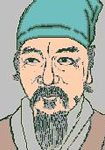“再來重約日西斜”的意思及全詩出處和翻譯賞析
“再來重約日西斜”全詩
臨流蘇小家。
畫闌曲徑宛秋蛇。
金英垂露華。
燒蜜炬,引蓮娃。
酒香薰臉霞。
再來重約日西斜。
倚門聽暮鴉。
分類: 醉桃源
作者簡介(周邦彥)

周邦彥(1056年-1121年),中國北宋末期著名的詞人,字美成,號清真居士,漢族,錢塘(今浙江杭州)人。歷官太學正、廬州教授、知溧水縣等。徽宗時為徽猷閣待制,提舉大晟府。精通音律,曾創作不少新詞調。作品多寫閨情、羈旅,也有詠物之作。格律謹嚴。語言典麗精雅。長調尤善鋪敘。為后來格律派詞人所宗。舊時詞論稱他為“詞家之冠”。有《清真集》傳世。
《醉桃源(大石·第二)》周邦彥 翻譯、賞析和詩意
《醉桃源(大石·第二)》是一首宋代的詩詞,作者是周邦彥。以下是詩詞的中文譯文、詩意和賞析:
中文譯文:
菖蒲葉老水平沙。
臨流蘇小家。
畫闌曲徑宛秋蛇。
金英垂露華。
燒蜜炬,引蓮娃。
酒香薰臉霞。
再來重約日西斜。
倚門聽暮鴉。
詩意:
這首詩描繪了一個寧靜美麗、令人陶醉的桃花源。桃花源指的是一個隱居人世、與世隔絕的理想之地。詩中通過描寫桃花源中的景物和情境,表達了作者對這個世外桃源的向往和追求。詩詞中融入了自然景色、人物形象和意境描寫,展現出對自然和閑適生活的向往與熱愛。
賞析:
1. 第一句“菖蒲葉老水平沙”,描繪了菖蒲葉子在水面上搖曳的景象,寓意自然的老邁與河灘上水平的沙地。這一句通過對自然景物的描寫,傳達出寧靜與歲月流轉的感覺。
2. 第二句“臨流蘇小家”,描述了作者臨近水流住著的小屋,流蘇可能指屋檐上的裝飾物。這里展示了作者隱居的生活環境,與自然和諧共處。
3. 第三句“畫闌曲徑宛秋蛇”,以畫闌和曲徑比喻寧靜的環境,宛秋蛇則描繪了蜿蜒曲折的小徑,營造出一種幽靜的意境。
4. 第四句“金英垂露華”,金英指桃花,垂露華則是指桃花上的露水。這一句通過描繪露水滴落在桃花上的美景,增添了自然的清新和生命的活力。
5. 第五句“燒蜜炬,引蓮娃”,燒蜜炬可能指的是燃燒的蜂蜜燭,蓮娃則是指蓮花的嬌艷。這一句描繪了桃花源中的熱鬧景象,融入了節日喜慶的氛圍。
6. 第六句“酒香薰臉霞”,表達了桃花源中酒香撲鼻的情景,融合了人與自然的交融。
7. 最后兩句“再來重約日西斜,倚門聽暮鴉”,表達了作者再次約會時太陽西斜、倚門聆聽暮鴉的場景,展現了作者享受寧靜生活的態度和心境。
整首詩以描繪桃花源中的自然景物和情境為主線,通過細膩的描寫和意境的營造,展示了作者對自然與寧靜生活的向往。這首詩既具有浪漫主義的情感表達,又融入了宋代詩詞的清新和自然《醉桃源(大石·第二)》 is a poem from the Song Dynasty, written by Zhou Bangyan. Here is the Chinese translation, the poetic meaning, and an analysis of the poem:
Chinese Translation:
菖蒲葉老水平沙。
臨流蘇小家。
畫闌曲徑宛秋蛇。
金英垂露華。
燒蜜炬,引蓮娃。
酒香薰臉霞。
再來重約日西斜。
倚門聽暮鴉。
Poetic Meaning:
This poem depicts a tranquil and enchanting peach blossom paradise. Peach Blossom Paradise refers to an ideal place of seclusion and detachment from the world. Through the depiction of the scenery and setting in Peach Blossom Paradise, the poet expresses his yearning and pursuit of this idyllic sanctuary. The poem incorporates descriptions of natural landscapes, characters, and imagery, revealing the poet's longing for and love of nature and a leisurely life.
Analysis:
1. The first line, "菖蒲葉老水平沙" (The old cattail leaves on the flat sand), portrays the swaying of cattail leaves on the water's surface, symbolizing the aging of nature along the flat sand. This line conveys a sense of tranquility and the passage of time through the description of natural elements.
2. The second line, "臨流蘇小家" (Living by the flowing stream, a small home), describes the poet's dwelling near the flowing stream, with "流蘇" possibly referring to decorative elements on the eaves. It showcases the poet's harmonious coexistence with nature in his secluded living environment.
3. The third line, "畫闌曲徑宛秋蛇" (A winding path like a meandering autumn snake beside the painted porch), uses the painted porch and winding path as metaphors for a peaceful environment. The imagery of a meandering autumn snake creates a serene atmosphere.
4. The fourth line, "金英垂露華" (Golden flowers dripping with dew), uses "金英" to refer to peach blossoms and "垂露華" to describe the dewdrops on the flowers. This line depicts the beauty of dewdrops on peach blossoms, adding a sense of freshness and vitality to nature.
5. The fifth line, "燒蜜炬,引蓮娃" (Burning honey candles, attracting lotus fairies), possibly describes the festive scene in Peach Blossom Paradise. The honey candles and lotus fairies evoke a sense of celebration and joy.
6. The sixth line, "酒香薰臉霞" (The fragrance of wine perfumes the rosy cheeks), conveys the scent of wine permeating the air in Peach Blossom Paradise, blending the essence of humans and nature.
7. The last two lines, "再來重約日西斜,倚門聽暮鴉" (Come again when the sun tilts to the west, leaning against the door to listen to the evening crows), express the scene of meeting again as the sun sets in the west, with the poet leaning against the door, listening to the crows of dusk. It portrays the poet's attitude and state of enjoying a peaceful life.
The entire poem revolves around the depiction of natural scenery and situations in Peach Blossom Paradise. Through delicate descriptions and the creation of imagery, the poet showcases his yearning for nature and a tranquil life. This poem embodies romantic expressions while incorporating the freshness and naturalness characteristic of Song Dynasty poetry.
“再來重約日西斜”全詩拼音讀音對照參考
zuì táo yuán dà shí dì èr
醉桃源(大石·第二)
chāng pú yè lǎo shuǐ píng shā.
菖蒲葉老水平沙。
lín liú sū xiǎo jiā.
臨流蘇小家。
huà lán qū jìng wǎn qiū shé.
畫闌曲徑宛秋蛇。
jīn yīng chuí lù huá.
金英垂露華。
shāo mì jù, yǐn lián wá.
燒蜜炬,引蓮娃。
jiǔ xiāng xūn liǎn xiá.
酒香薰臉霞。
zài lái zhòng yuē rì xī xié.
再來重約日西斜。
yǐ mén tīng mù yā.
倚門聽暮鴉。
“再來重約日西斜”平仄韻腳
平仄:仄平仄平仄平平
韻腳:(平韻) 下平六麻 * 平仄拼音來自網絡,僅供參考;詩句韻腳有多個的時候,對比全詩即可判斷。